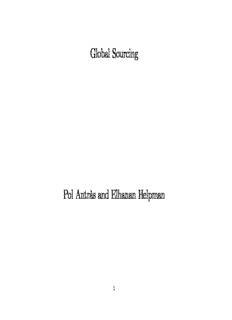
Global Sourcing Pol Antràs and Elhanan Helpman PDF
Preview Global Sourcing Pol Antràs and Elhanan Helpman
Global Sourcing Pol Antràs and Elhanan Helpman 1 Background Old trade theory: cross-country differences drive trade (technology, endowments); emphasis on intersectoral trade flows (intersectoral specialization); factor content. New trade theory: adds intra-industry specialization (intra-industry trade, intra-firm trade): helps explain large volumes of trade between similar countries • helps explain variations in the share of intra-industry trade and • intra-firm trade. 2 Background (Cont.) The theory was developed for trade in final goods and intermedi- ate inputs. Nevertheless, within sectors, firms are symmetrically structured (for the most part). Occasional heterogeneity emerges from indifference. In the data a lot of within industry heterogeneity. • Participation in trade is related to firm characteristics. • The modelling of intra-firm trade is unsatisfactory — common failure to model internalization — cf. Tirole (1988), Hart (1995), 3 Main Questions How do firms choose to organize production? What are their global sourcing strategies? Choice between domestic vs. foreign production of intermediate • inputs. Choice between intrafirm vs. arm’s length purchase of interme- • diate inputs. Are these decisions interrelated? • How do they depend on industry characteristics? And on firm • characteristics? And on country characteristics? 4 Answers to these questions should help to explain recent trends: growing international specialization — see quotes in paper • FDI and trade growing faster than GDP • bias towards arm’s length relations in the composition of trade • (and also in the composition of U.S. manufacturing). 5 Backbones of the Model Recent developments have emphasized within sectoral heterogeneity and the organization of production. Melitz (2003) and Helpman et al. (2003) study the effects of • within sectoral heterogeneity — only more productive firms en- gage in high fixed-cost strategies — e.g., exporting, FDI. Grossman and Helpman (2002) and Antràs (2003) study the • choice of organizational structure under incomplete contracts and its effects on the form of international trade (variations across industries) — e.g., higher share of intrafirm trade in capital- intensive sectors. 6 Preview of Some Results We describe industry equilibria in which only high-productivity • firms engage in international trade in components. We predict a predominance of arm’s length relationships in sectors • where headquarter services are relatively unimportant. We describe equilibria in headquarter-intensive sectors, with do- • mestic and foreign integration, as well as domestic and foreign outsourcing. 7 Preview of Some Results (Cont.) Relative prevalence of different organizational forms is related to: • — firm characteristics (productivity level) — industry characteristics (R&D intensity, productivity disper- sion, bargaining power) — country characteristics (relative wages, contractual environment). 8 The Model Two countries: the North and the South. 1 J µ Preferences are quasi-linear: U = x + X , 0 < µ < 1. 0 µ j=1 j 1/α Pα Subutility in sector j is X = x (i) di , 0 < µ < α < 1. j j • µ α α 1 Inverse demand function is p £(Ri) = X ¤x (i) . j j − j − • Producers of differentiated goods face a perfectly elastic supply of N S labor (w > w ). Monopolistic competition in final-good markets. 9 The Model (Cont.) N Entry costs: w f . Productivity θ revealed after entry. E Production function (specialized inputs): η 1 η j j h (i) m (i) − j j x (i) = θ , 0 < η < 1. j j η 1 η Ã j ! Ã j! − h controlled by final-good producer (agent H), m by operator of production facility (agent M); both in-house and at arm’s length. Sectors vary in intensity of headquarter services η ; within sectors, j firms differ in productivity θ. Intermediates are produced using labor with a fixed coefficient; h (i) j produced only in the North H is always in the North. → 10
Description: